Text
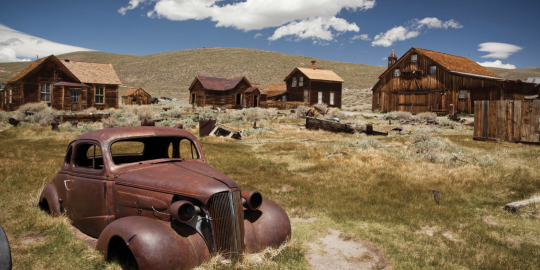
Bodie, California
Bodi is a ghost town in the Bodie Hills east of the Sierra Nevada mountain range in Mono County, California, United States. It is about 75 miles (121 km) southeast of Lake Tahoe, and 12 mi (19 km) east-southeast of Bridgeport, at an elevation of 8,379 feet (2554 m). Bodie became a boom town in 1876 (147 years ago) after the discovery of a profitable vein of gold; by 1879 it had established 2,000 structures with a population of roughly 8,000 people. The town went into decline in the subsequent decades and came to be described as a ghost town by 1915 (108 years ago). The U.S. Department of the Interior recognizes the designated Bodie Historic District as a National Historic Landmark. Also registered as a California Historical Landmark, the ghost town officially was established as Bodie State Historic Park in 1962. It receives about 200,000 visitors yearly. Bodie State Historic Park is partly supported by the Bodie Foundation.
Read more
#bodie#ghost town#abandoned#california#wikipedia#weird facts#weird history#strange facts#strange history#random fact#weird wikipedia#wikiweird#history
25 notes
·
View notes
Text

Bucket of Blood Street is located off U.S. Route 66 in the Old Downtown district of Holbrook, Arizona. Bucket of Blood Street is one block south of the historical Santa Fe Railroad station on Navajo Road that was built in 1882. Holbrook was founded in the 1880s as a railroad stop. At the time, the desert town was mainly populated by ranchers, outlaws, cowboys and cattle rustlers, and was known for its gun fights. Holbrook had a reputation as a "town too tough for women and churches".
Terrell's Cottage Saloon had existed on the street for years before coming to be known as Bucket of Blood Saloon, after a violent fight took place resulting in the death of two men. The saloon was popular with cowboys and ruffians; fistfights and gunfights often broke out there. The year 1886 was a particularly violent one and the town lost about ten percent of its population. A fight broke out at the saloon during a card game between rival cattle rustlers, including wranglers from the Hashknife Outfit of the Aztec Land and Cattle Company. The result of the fight was described as though a bucket of blood had been spilled on the floor.
A newspaper account describes another event on January 19, 1896, when the proprietor of the saloon shot and killed two men playing cards: "Suddenly a dispute arose and angry words passed between them." The manager of the saloon, Harry Donnelly, used a revolver to force another man, George C. Hiatt, a barber, into the street and shot him "through the heart" in front of the town drug store. Donnelly was arrested by Deputy Sheriff Hofford who was acting as the county sheriff, as Commodore Perry Owens was out of town at the time. The newspaper report claims that when the widow Hiatt heard the news she fell "lifeless to the floor". The saloon was owned at the time by F. J. Wattron, however Donnelly managed it.
Albert F. Potter's memoir, written around 1888, describes the events leading to the name Bucket of Blood somewhat differently. He wrote of participating in a "roundup on the Little Colorado River range … 12 miles east of Holbrook." At sunrise two horsemen were seen riding towards his party from the direction of Holbrook. One man shouted, "Here we come! All shot to pieces." The head of the other man was wrapped in bloody bandages covering a serious wound. Potter went on to write: "We recognized them as Joe Crawford, a cowboy who had worked for the Aztec Land and Cattle Company known as the Hashknife Outfit, and George Bell, a gambler. Crawford was so weak [from his wounds] that he had to be lifted from the horse he was riding. We laid him on the horse wrangler's bed and with a handful of flour from the cook's bread pan I plastered the wound on his head and stopped the bleeding. Examination showed that a bullet had also passed through the cuff of his shirt and coat sleeve, and just grazed the side of his body. Scars of other old wounds showed that this was not Crawford's first fight."
Potter then describes Bell's involvement in an incident during a card game with a man named Ramon Lopez, during which Lopez struck Crawford in the head with his six-shooter gun. Crawford retaliated by drawing his gun and killing Lopez. Shooting then broke out in the saloon, and Crawford killed another man, after which "Crawford and Bell then made their getaway". Potter went on to write that he believed Joe Crawford "was in fact Grat Dalton, a member of the notorious Dalton Gang of outlaws who was later killed during an attempted bank robbery at Coffeyville, Kansas". Potter concluded that this was the backstory to the naming of Bucket of Blood Saloon.
Read more
#wikipedia#weird facts#weird history#strange facts#strange history#random fact#weird wikipedia#wikiweird#history
43 notes
·
View notes
Text
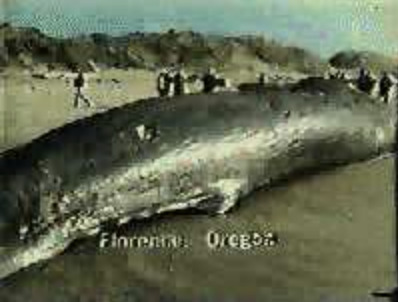

Exploding whale
The "Exploding whale" article recounts a peculiar incident that took place in 1970 in Florence, Oregon. It describes the attempts made by local authorities to dispose of a dead sperm whale that had washed ashore, which ultimately resulted in a rather unexpected and messy outcome.
The article provides details of how authorities decided to use dynamite to remove the carcass of the whale from the beach, assuming that the explosion would disintegrate the remains and seagulls would eat the smaller pieces. However, the explosion was far more powerful than anticipated, sending chunks of blubber flying in all directions, damaging nearby vehicles, and creating an unpleasant odor.
The incident gained significant media attention, and video footage of the exploding whale circulated widely, turning it into a memorable and somewhat bizarre event in local history.
Read more
#exploding whale#whale#marine biology#wikipedia#weird facts#weird history#strange facts#strange history#random fact#weird wikipedia#wikiweird
93 notes
·
View notes
Text

Space elevator
The "Space elevator" article discusses a hypothetical structure that would allow for transportation between Earth and space using a cable extending from the surface of the planet to a counterweight in space. The concept of a space elevator has been proposed as a potential alternative to traditional rocket-based space launches.
The article explores the history and development of the space elevator concept, including early theoretical discussions and the contributions of notable scientists and engineers. It covers the various components and challenges involved in constructing a space elevator, such as the design of the cable, the anchor on Earth, and the counterweight in space.
The article also delves into the potential benefits and applications of space elevators, such as reduced launch costs, more efficient space missions, and the potential for space tourism and exploration.
It discusses the technical and engineering challenges associated with building a space elevator, including material strength requirements, Earth's gravity, and the need for advanced transportation systems.
Please note that the concept of a space elevator is currently theoretical and not yet realized. The article presents the current state of knowledge and research in this field, but it is important to recognize that significant technological advancements and breakthroughs would be required to make a space elevator a reality.
Read more
#space#NASA#astrology#astronomy#outer space#wikipedia#weird facts#weird history#strange facts#strange history#random fact#weird wikipedia#wikiweird#history
7 notes
·
View notes
Text

Sandy Davidson
Sandy Jardine Davidson (born 28 May 1972) is a Scottish boy who disappeared on 23 April 1976, when he was three years old, while he was playing in the back garden of his house in the Bourtreehill housing estate in Irvine, Ayrshire.
On 23 April 1976, Sandy Davidson was in his garden with his little sister Donna playing with their dog. They were being looked after by their grandparents, who had gone inside the house at the time. The gate flew open, and their dog ran out. Sandy ran out, trying to catch him. His sister Donna says that all she can remember was Sandy motioning for her to go too, but she refused and went into the house to tell their grandparents. Work ground to a halt on the new building estate nearby to search for Sandy, but nobody has seen him since.
The most believed scenario is that there was a man delivering leaflets around the time of Sandy's disappearance and that he could have opened the gate and taken Sandy. Sandy's mother, Margaret, and father Phillip believe that it was a lonely man wanting a son. Another theory is that he ran down to the river five minutes away and followed the dog in, and subsequently drowned.
Read more
#missing#forensic#unsolved mysteries#wikipedia#weird facts#weird history#strange facts#strange history#random fact#weird wikipedia#wikiweird
4 notes
·
View notes
Text

Great Moon Hoax -
In the late 18th century, there was a bizarre event known as the "Great Moon Hoax." In 1835, a series of articles were published in the New York Sun newspaper claiming that a renowned astronomer named Sir John Herschel had made groundbreaking discoveries about the Moon.
The articles claimed that Herschel had built a powerful telescope that allowed him to observe the Moon in unprecedented detail. According to the reports, Herschel had discovered an array of astonishing lunar creatures and features, including bat-like winged humanoids, beaver-like creatures, unicorn-like bipeds, and lush vegetation.
The descriptions provided vivid and detailed accounts of these supposed lunar inhabitants, along with intricate diagrams and illustrations. The articles captivated the public, and the "discoveries" were widely discussed and believed by many.
However, it was later revealed that the entire series of articles was a hoax. The author was Richard Adams Locke, a journalist and writer who intended to satirize the state of sensational journalism of the time. The Great Moon Hoax was a remarkable example of how a fictional account could captivate the public and deceive readers.
The Great Moon Hoax serves as a reminder of the power of storytelling and the human tendency to be fascinated by the unknown and the extraordinary. It also highlights the importance of critical thinking and skepticism, even when faced with seemingly credible information.
#great moon hoax#moon hoax#hoax#wikipedia#weird facts#weird history#strange facts#strange history#random fact
31 notes
·
View notes
Text

Campden Wonder
The Campden Wonder refers to a notorious historical event that occurred in England in the 17th century. It revolves around the mysterious disappearance and subsequent reappearance of three individuals from the Campden family in Chipping Campden, Gloucestershire.
In August 1660, a prominent gentleman named William Harrison disappeared without a trace. Suspicion fell upon his servant, John Perry, who was known to have a contentious relationship with Harrison. Perry, along with his mother Joan and his brother Richard, were accused of murdering Harrison and disposing of his body.
During the trial, Joan Perry confessed to the murder and claimed that her sons assisted her. The three were found guilty and subsequently executed in March 1661. However, in 1662, William Harrison returned alive and well, creating a sensation and raising questions about the validity of the Perry family's confessions.
The reappearance of William Harrison created a legal conundrum known as the "Campden Wonder." An investigation was conducted to determine how the Perrys' confessions were obtained and whether they were coerced. It was discovered that the Perrys had falsely confessed under duress during their interrogations.
As a result, the posthumous pardons of Joan, John, and Richard Perry were granted, and their bodies were exhumed and given proper burials. The Campden Wonder became a notable case highlighting the importance of fair trials and the potential for wrongful convictions.
The exact circumstances surrounding the disappearance of William Harrison and his subsequent return remain unclear. The case of the Campden Wonder has captured the imagination of historians and has been the subject of books, plays, and discussions examining the legal and social implications of the event.
Read more
#Campden Wonder#campden#William Harrison#unsolved mystery#mystery#wikipedia#weird facts#weird history#strange facts#strange history#random fact#weird wikipedia#wikiweird#history
3 notes
·
View notes
Text

Homicidal sleepwalking
The "Homicidal sleepwalking" article explores a rare and unusual phenomenon in which individuals commit acts of violence, including murder, while in a state of sleepwalking. The article delves into documented cases of homicidal sleepwalking throughout history and examines the legal and medical implications of such incidents.
It discusses notable cases where individuals have been accused of and even convicted of committing violent acts while sleepwalking. The article delves into the challenges faced by the legal system in determining culpability and establishing the intent of individuals who commit crimes during sleepwalking episodes.
The article also explores the medical understanding of sleepwalking and its various forms, including homicidal sleepwalking. It delves into possible causes, triggers, and risk factors associated with this particular type of sleep disorder.
Please note that while homicidal sleepwalking is a real phenomenon, it is extremely rare. The article provides insights into the documented cases and scientific research surrounding this unusual sleep disorder, shedding light on the complexities of the human mind and the mysteries of sleep behavior disorders.
Read more
#sleepwalking#macbeth#true crime#wikipedia#weird facts#weird history#strange facts#strange history#random fact#weird wikipedia#wikiweird#psychology
30 notes
·
View notes
Text

Kentucky meat shower
The Kentucky Meat Shower refers to a peculiar incident that took place on March 3, 1876, in Bath County, Kentucky, USA. The event involved chunks of meat seemingly falling from the sky, mystifying the witnesses and leading to various explanations and theories.
According to contemporary reports, a sudden rain of meat occurred in a rural area near the town of Olympia Springs. The meat was described as small, reddish in color, and ranging in size from flakes to larger pieces. It was said to have covered an area of several acres.
Witnesses at the scene reported the meat to have a strange odor and texture. Some individuals even tasted it, leading to different opinions about its origin. Speculations ranged from the notion that it was a heavenly phenomenon to the idea that it was the result of vultures disgorging their contents mid-flight.
Local authorities and scientists were called in to investigate the event. One scientist, Dr. A. Mead Edwards, conducted an examination and concluded that the meat was of muscular origin, resembling either beef or mutton. He suggested that the meat shower might have been caused by a flock of vultures flying overhead and regurgitating their prey.
Despite the investigation, the exact cause of the Kentucky Meat Shower remains uncertain. The incident has become a subject of curiosity and speculation, with numerous theories proposed over the years. Some theories propose that the meat may have been carried by a strong wind from a nearby slaughterhouse, while others suggest it could have been the result of a meteorological event.
The Kentucky Meat Shower continues to captivate the imagination of those interested in unusual and unexplained phenomena. While it remains an intriguing historical event, the specific circumstances surrounding the incident remain a mystery, and it is unlikely that a definitive explanation will ever be determined.
Read more
#kentucky#kentucky meat shower#unsolved mystery#mystery#wikipedia#weird facts#weird history#strange facts#strange history#random fact#weird wikipedia#wikiweird#history
159 notes
·
View notes
Text
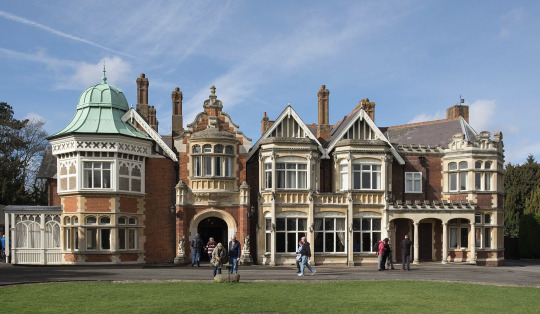
Bletchley Park
Bletchley Park is a historic site located in Bletchley, England. During World War II, it served as the central site for British codebreakers who worked to decrypt and analyze encrypted messages from German and other Axis powers' communications.
The article provides an overview of Bletchley Park's role as a key intelligence hub during the war. It highlights the efforts of notable codebreakers such as Alan Turing, Gordon Welchman, and others who played a crucial role in breaking the Enigma cipher used by the Germans.
Bletchley Park housed a diverse group of individuals with various skills, including mathematicians, linguists, chess champions, and crossword enthusiasts. Their collective efforts led to significant breakthroughs in deciphering intercepted enemy messages, providing vital intelligence to the Allied forces.
The article delves into the codebreaking techniques and technologies employed at Bletchley Park, including the development of electromechanical machines like the Bombe and the pioneering work in early computing, such as Turing's design for the automatic computing engine.
After the war, much of the work conducted at Bletchley Park remained classified for many years. However, the site has since been opened to the public as a museum and heritage site, offering visitors the opportunity to explore the history of codebreaking and its impact on the outcome of World War II.
Bletchley Park stands as a symbol of the remarkable intellectual efforts and achievements of the codebreakers who worked tirelessly to crack enemy codes, contributing significantly to the Allied war effort and shaping the course of history.
Read more
#Bletchley Park#WWII#WW2#wikipedia#weird facts#weird history#strange facts#strange history#random fact#weird wikipedia#wikiweird#history
5 notes
·
View notes
Text

The Vela Incident -
In 1979, a Vela satellite operated by the United States detected a mysterious double flash of light in the vicinity of the Indian Ocean. The double flash had the characteristics of a nuclear explosion, leading to speculation that it might have been a secret nuclear test conducted by a nation.
What makes this event particularly intriguing is that the source of the double flash remains unidentified to this day. Despite extensive investigations by various intelligence agencies and experts, no definitive explanation has been found.
Several theories have been proposed, ranging from a covert nuclear test by an unknown country to a natural phenomenon such as a meteoroid impact or a lightning discharge. However, no concrete evidence has surfaced to confirm any of these hypotheses.
The Vela incident, as it is commonly known, continues to be a mystery and subject of speculation in the realm of nuclear detection and international relations. It serves as a reminder of the complexities and unknowns that exist even in our technologically advanced world, where certain events can defy explanation and remain shrouded in uncertainty.
#Vela incident#vela#the Vela incident#wikipedia#weird facts#weird history#strange facts#strange history#random fact
1 note
·
View note
Text

Simo Häyhä
During World War II, a Finnish soldier named Simo Häyhä achieved an astonishing feat as a sniper. He is often referred to as the "White Death." Häyhä fought in the Winter War between Finland and the Soviet Union in 1939-1940.
Using a Finnish variant of the Soviet Mosin-Nagant rifle, Häyhä became one of the deadliest snipers in history. He operated in freezing temperatures, often hiding in the snow for extended periods. Häyhä amassed an incredible kill count of at least 505 confirmed kills, all within a span of about 100 days. This number is even more remarkable considering that Finland's population at the time was around 3.7 million.
What makes Häyhä's achievement even more astonishing is that he accomplished it without using a telescopic sight. Instead, he relied on iron sights, which provided less magnification and made his shots even more challenging. Additionally, he camouflaged himself well, using snow and vegetation to blend into his surroundings and make it difficult for enemies to spot him.
Häyhä's skill and stealth made him a feared adversary, and the Soviets actively tried to eliminate him by counter-snipers and artillery strikes. However, he survived the war despite being shot in the face at one point. Häyhä ultimately retired as a highly decorated soldier and lived a long life until his death in 2002.
Simo Häyhä's remarkable achievements as a sniper during World War II continue to capture the imagination and stand as a testament to his extraordinary skill, resilience, and the harsh realities of war.
Read more
#strange history#random fact#weird wikipedia#wikiweird#wikipedia#weird facts#weird history#strange facts#history#ww2#WWII#Simo Häyhä
27 notes
·
View notes
Text
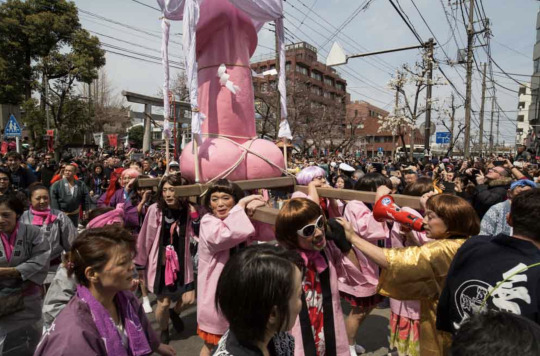
Kanamara Matsuri
The Festival of the Steel Phallus takes place on the first Sunday of April and attracts thousands of visitors from around the world. The event centers around the Kanayama Shrine, which has a long history of worshiping fertility and protection against sexually transmitted infections.
During the festival, a colorful parade featuring large phallic-shaped objects and floats moves through the streets. Participants carry portable shrines, or mikoshi, shaped like phalluses. The main highlight is a massive pink steel phallus that is paraded through the town and later displayed at the shrine.
The festival is said to have originated in the 17th century when sex workers prayed for protection against sexually transmitted diseases. Over time, it evolved into a celebration of fertility, marriage, and protection against various ailments.
Today, the Festival of the Steel Phallus has become a lighthearted and lively event that aims to promote sexual health education and break taboos surrounding sexuality in Japanese society. The festival also raises funds for HIV research and other charitable causes.
Read more
#wikipedia#weird facts#weird history#strange facts#strange history#random fact#weird wikipedia#wikiweird#Kanamara Matsuri#Japan#japanese
19 notes
·
View notes
Text

Expanding Earth
The Expanding Earth Theory is a scientific concept that proposes that the Earth's crust has been gradually increasing in size over geological time, causing the continents to move apart. This theory stands in contrast to the widely accepted theory of plate tectonics, which suggests that the Earth's lithosphere is divided into several rigid plates that move and interact with each other.
The Expanding Earth Theory suggests that as the Earth expands, the continents move away from each other, creating new oceanic crust between them. It argues that the growth of the Earth is responsible for the observed continental drift and the formation of ocean basins. Proponents of this theory argue that it can explain various geological features, such as the fit of continents, the distribution of ancient fossils, and the formation of mountain ranges.
However, it is important to note that the Expanding Earth Theory is not widely accepted within the scientific community. The theory faces numerous challenges and conflicts with a vast amount of geological and geophysical evidence that supports plate tectonics. The overwhelming consensus among scientists is that plate tectonics is the prevailing mechanism responsible for the movement of Earth's crust and the formation of geological features.
Plate tectonics provides a more comprehensive and well-supported framework for understanding the Earth's geological processes, including the formation of mountain ranges, the distribution of earthquakes and volcanic activity, and the evolution of continents over millions of years.
While the Expanding Earth Theory has not gained mainstream scientific acceptance, it still attracts some interest from fringe or alternative science communities. However, it is crucial to approach scientific theories with skepticism and rely on evidence-based consensus within the scientific community for a well-founded understanding of Earth's geological processes.
Read more
#Expanding Earth#theory#growing earth#wikipedia#weird facts#weird history#strange facts#strange history#random fact#weird wikipedia#wikiweird
1 note
·
View note
Text

Impossible color
Impossible colors are colors that do not appear in ordinary visual functioning. Different color theories suggest different hypothetical colors that humans are incapable of perceiving for one reason or another, and fictional colors are routinely created in popular culture. While some such colors have no basis in reality, phenomena such as cone cell fatigue enable colors to be perceived in certain circumstances that would not be otherwise.
Read more
#Impossible color#impossible#wikipedia#weird facts#weird history#strange facts#strange history#random fact#weird wikipedia#wikiweird#color palette#color theory
1 note
·
View note
Text
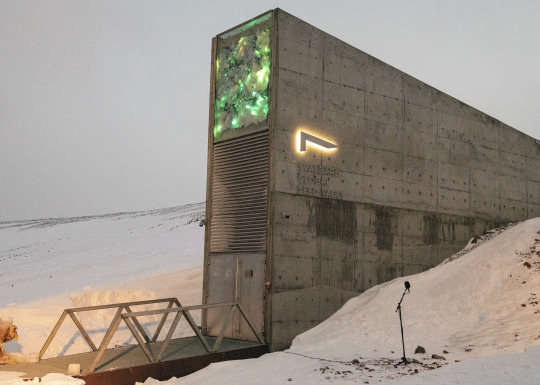
Svalbard Global Seed Vault
The Svalbard Global Seed Vault is a secure seed bank located on the Norwegian island of Spitsbergen, near Longyearbyen. It was established in 2008 as a global backup facility to preserve and protect the world's crop diversity in case of regional or global catastrophes.
Often referred to as the "Doomsday Vault," the seed vault is built into a mountainside and designed to withstand natural and human-made disasters, including earthquakes and nuclear war. It is situated in the permafrost, providing natural cooling and preserving the seeds at a constant low temperature.
The purpose of the seed vault is to safeguard the world's agricultural heritage and ensure the availability of diverse plant genetic resources for future generations. The vault acts as a repository, storing duplicate seed samples from gene banks around the world. These samples represent a wide range of important food crops and plant species.
The seed vault currently holds over one million different seed samples, with the capacity to store up to 4.5 million samples. It serves as a long-term insurance policy for global food security, as it allows for the reestablishment of crops in the event of a major regional or global catastrophe.
The Svalbard Global Seed Vault is an important international initiative, symbolizing the collective efforts to safeguard the world's agricultural heritage and ensure the resilience of food systems.
Read more
#wikipedia#weird facts#weird history#strange facts#strange history#random fact#weird wikipedia#wikiweird#Svalbard Global Seed Vault#doomsday#bunker
41 notes
·
View notes
Text

List of people who have lived at airports
The "List of people who have lived at airports" article catalogues individuals who, for various reasons, have taken up residence or lived in airports for extended periods of time. These circumstances may include immigration issues, political asylum requests, or personal choices.
The article provides information about notable cases of people living at airports, including details about their experiences, the duration of their stay, and the circumstances surrounding their presence. It covers instances from different parts of the world and explores the legal and logistical challenges faced by both the individuals and airport authorities.
Living in an airport can present unique challenges, as individuals may face uncertainty regarding their legal status, limited access to amenities, and the need to navigate complex immigration processes.
Read more
#list#airport#wikipedia#weird facts#weird history#strange facts#strange history#random fact#weird wikipedia#wikiweird#history
1 note
·
View note